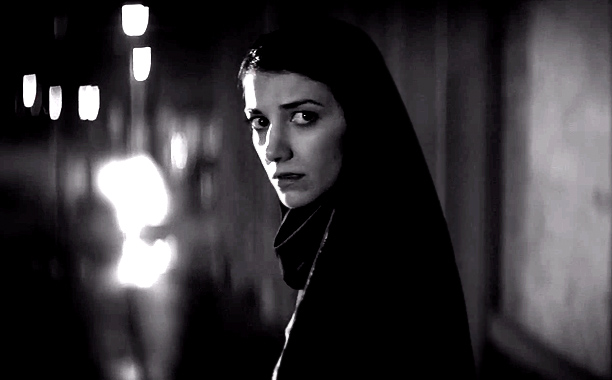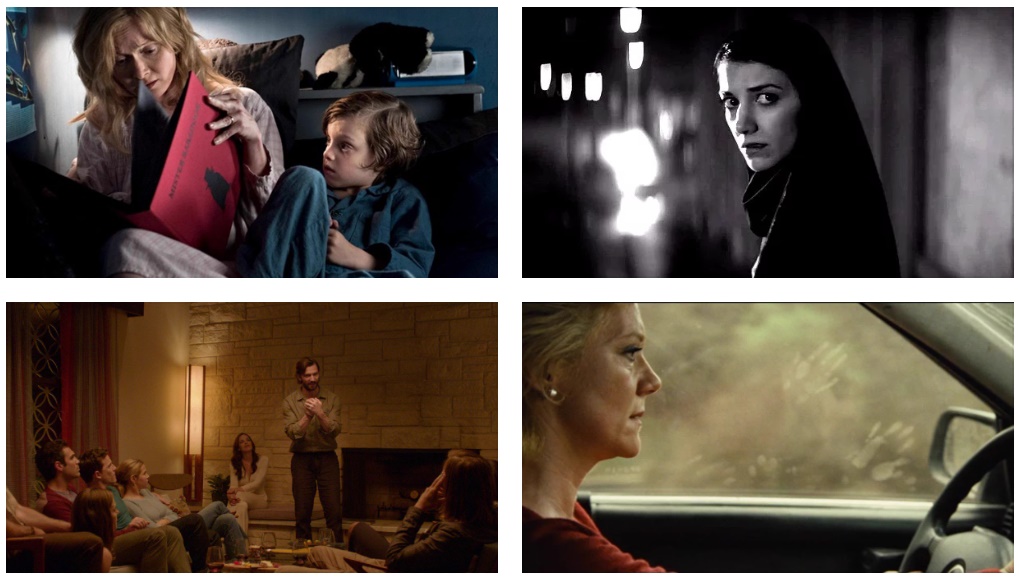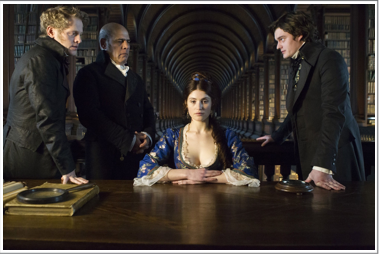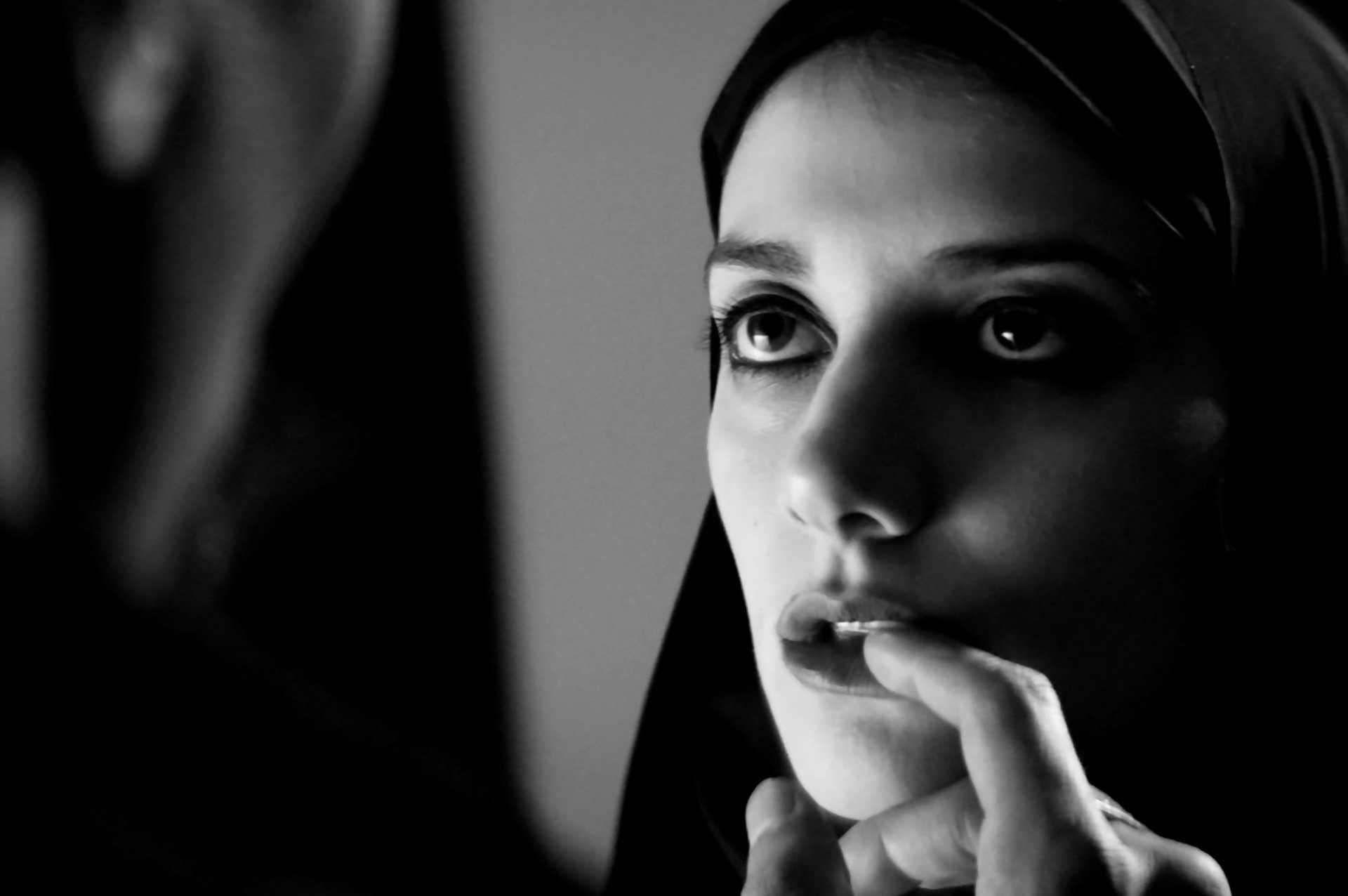This guest post written by Samantha Cross appears as part of our theme week on Women Directors.
The vampire as metaphor has had a fascinating staying power since Bram Stoker’s Dracula turned Eastern European folklore into a gothic tale of sexual repression and liberation. At times, vampires are feral beasts of horror or sexy, brooding heroes tortured by their own immortality. Or… Twilight. The point is that vampires, while we may associate them with certain traits, can be as powerful, vulnerable, and insightful as the narrative allows. Their monstrosity is subjective, giving storytellers ample room to explore the nature of vampires and the worlds they inhabit. In A Girl Walks Home Alone at Night, writer/director Ana Lily Amirpour crafts a vampire that is neither virtuous nor villain, but somewhere in between. Though she is what we would typically classify as a “monster,” it becomes clear that Bad City has more than its fair share of demons.
Billed as “the first Iranian vampire Western,” A Girl Walks Home Alone at Night exists in a deliberately nebulous space, keeping it open to interpretation. One can view it through a feminist lens as The Girl (Sheila Vand) primarily attacks men who bully and exert their own power on others, mainly coming to the defense of a sex worker, Atti (Mozhan Marnò), who’s connected to both Saeed (Dominic Rains) the local drug dealer and Arash’s (Arash Marandi) father who struggles with addiction, Hossein (Marshall Manesh). There’s also commentary to be gleaned from the frequent shots of oil rigs, the open, almost casual display of dead bodies in a ditch, and the stagnant feel of Bad City that appears to be stuck in several time periods as the director’s feelings on Iran and the country’s culture. Amirpour, however, finds the interpretation to be more reflective of the interpreter. As for her own view on the themes in her film, she told the Los Angeles Times:
“In this case, it’s really about loneliness. A vampire is the loneliest, most isolated cut-off type of creature. She also has something very bad to hide about who she is and it’s a brilliant disguise. It becomes a way to stay under the radar and underestimated. There are a million ways to read it. It will tell you more about you than it does about me.”
Upon a second viewing of the film, through my most critical eye (the left one), I think Amirpour’s ideas of loneliness, coupled with the elements of disguise and isolation, fit in perfectly with what should be called an “industrial” Western. Like John Ford, Amirpour uses her wide shots to establish the vast landscape of the film’s world, but instead of lush valleys and sweeping canyons we get a flat, barren desert where oil rigs have replaced the painted hills. We’re not meant to look upon Bad City and its surroundings with awe. We’re meant to understand how singular it is, a mirage of a vibrant city filled with vagrants and criminals who prey upon the less fortunate; a place where everyone who can is trying to get out of Dodge by any means necessary. Basic setup for your Magnificent Sevens, Silverados, or Unforgivens, right?
Enter The Girl, a mostly silent observer to the rotting underbelly of Bad City. She shares a kinship with the likes of Shane and The Man with No Name — a hero with mysterious origins and questionable morality who ultimately defends those who cannot help themselves. It’s a slow buildup to her first appearance in the movie, roughly fifteen minutes, but Amirpour devotes that time to crafting the right circumstances for The Girl to enter and sets up how one decision leads the rest of the film onward.
One such means of exploration is through a tried-and-true staple of Westerns: the standoff. The highlight of many films, it can be as simple as a duel at high noon or as action-packed as a ragtag group of hired guns staring down another group of hired guns for possession of a small town. It’s a moment of tension designed to make the payoff, ya know, killing someone, that much more intense. Amirpour flips the script, so to speak, using the standoff for the deliberate purpose of taunting The Girl’s potential victims as well as the audience. She establishes a pattern early on: observe, follow, and strike. The cover of night adds to the horror element and the heightened sound makes her footsteps audible, but The Girl stays far enough away that her marks are unnerved just enough by her presence. I’m especially fond of her shadow game with Hossein. It’s humorous but still cut with the right amount of suspicion over how it will play out given her previous encounter with Saeed earlier in the film. It’s only when she’s ready to strike that the gap closes and the standoff ends. The kill becomes an intimate yet feral moment because, unlike her male counterparts who brandish guns at a distance, The Girl’s sole weapon is her own body.
The standoff within A Girl Walks Home Alone at Night also applies to Amirpour’s use of close-ups. A lot of time is spent in keeping the tension as tight as possible, especially once we know The Girl’s game and how she executes her brand of “justice.” Because The Girl is a taciturn character, the emotional beats and her contemplative nature have to be seen up close, which, in turn, heightens the anxiety of the scene even more. The intimacy of the shots between The Girl and Arash are rife with romantic tension, but there’s a similar feeling of dread as the camera cuts back and forth. Her proximity may very well mean death for the second party. It’s a standoff created by the camera, somewhat reminiscent of Sergio Leone, but Amirpour relies more on letting the takes breathe instead of intensive cutting, letting Vand and Marandi’s eyes convey far more than the dialogue.
In many ways, The Girl resembles a comic book vigilante as much as a cowboy anti-hero. I mean, come on; a silent avenger of the night draped in black who inspires as much fear as the monsters she fights? Where have I seen that before? Batman, obviously. The heroic element was not lost on Amirpour either, though her inspiration came more from The Girl’s choice of costume:
“In Iran, I have had to wear a hijab [headscarf], and personally I find it completely suffocating. I don’t want to be covered up in all that cloth. But there was something about the chador though. It’s made of a different fabric. It’s soft and silky and it catches the air. When I put it on, I felt supernatural. But I also get to take it off.”
The themes of disguise and concealment are as endemic to Westerns as they are to superheroes. Cinematic cowboys are always running from something — the law, their past — so remaking themselves and hiding from their previous actions requires some measure of disguise, whether it’s a new name or a handy little domino mask. Either way, the conclusion is the same: you can never truly escape who you are. The Girl goes through a similar struggle. Atti asks The Girl, after a very strange conversation, “What are you?” Amirpour then cuts to The Girl back on the streets, seemingly contemplating this question, as she slowly approaches and feeds on a homeless man. It’s not the subtlest piece of character development, but it serves to address the supposed virtue of the The Girl. Stalking the villains of Bad City is easy enough, but what’s a vampire to do when they’re not readily available?
The Girl, for all intents and purposes, is hiding from herself. The chador acts as her cape and cowl but it’s also a line of demarcation. When she walks the streets of Bad City, she’s a shadow, a spectre haunting the less than savory elements of the city. When she takes off the chador, she’s a seemingly young woman who finds solace in sad songs and dances to synth-pop surrounded by musical icons. Her hunger and the nature of that hunger are never addressed until it begins to conflict with the small yet complicated entanglements known as human relationships. As a side note, when The Girl and Arash meet and speak to each other for the first time, Arash – high as a kite – is wearing a Dracula costume from a party. It’s a brilliant juxtaposition that the two begin to form their romance when both are essentially in disguise. And it’s probably my favorite scene in the movie.
A Girl Walks Home Alone at Night, is still well worth your time if you have any interest in the work of upcoming directors like Amirpour or desire something more substantial from your vampire-themed entertainment. There are also two issues of a comic book written by Amirpour available for purchase that give you some background on The Girl.
See also at Bitch Flicks:
A Girl Walks Home Alone at Night and Scares Us
Feminist Fangs: The Activist Symbolism of Violent Vampire Women
10 Women-Directed Films for Halloween
Samantha “Sam” Cross is best described as a poly-geek, soaking up as much information as possible to better appreciate the things she loves. An archivist by trade, she’s also a fan of comic books, movies, music, and television, never shying away from talking about or analyzing pop culture minutiae. You can listen to her as the host of That Girl with the Curls podcast where she chats about her pop culture obsession in the company of friends or with special guests. Follow her @darling_sammy on Twitter.





























